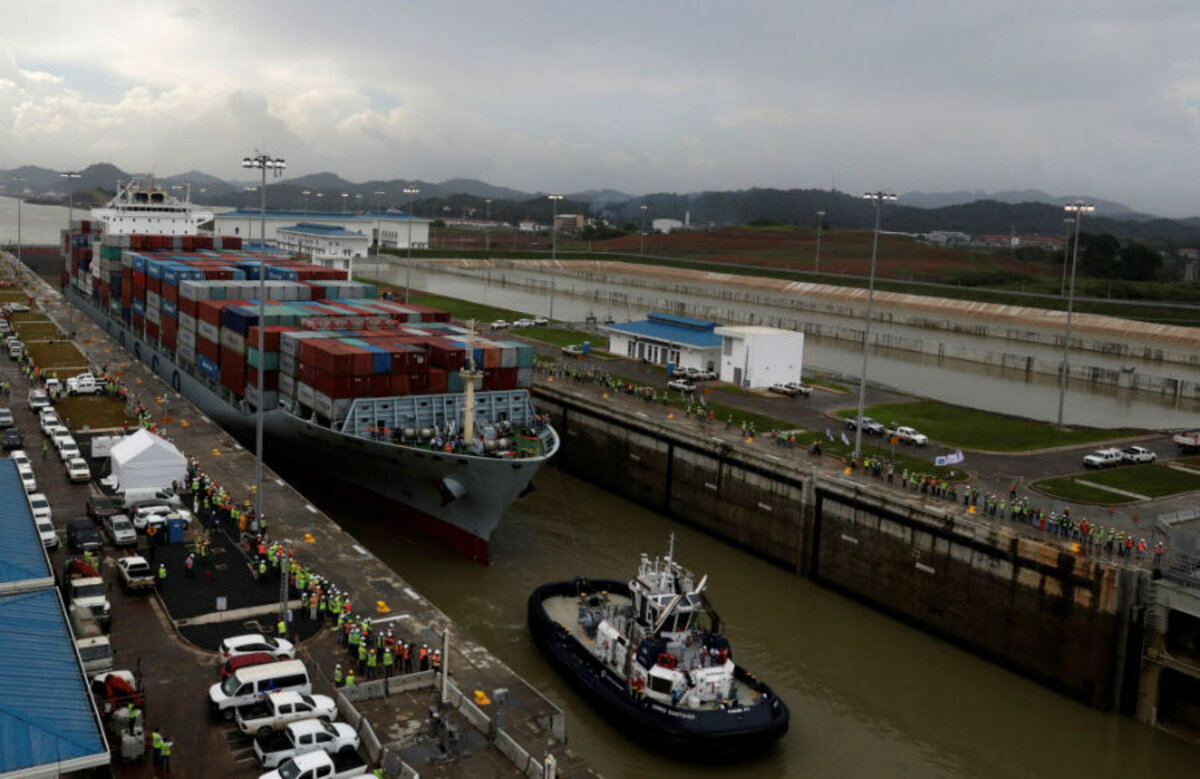How the improved Panama Canal could change world trade
Loading...
When the Panama Canal was completed in 1914, it became a centerpiece in US global ambitions. By interests and influence in the Atlantic with the nation’s rising power in the Pacific, the 50-mile long canal – whose construction cost thousands of lives – revolutionized how products moved from East to West and vice-versa.
Just over a 100 years later, after a , the Panama Canal is poised to again transform global trade dynamics. When the restructured canal is inaugurated on Sunday, it has the potential to vastly effect the volume of business in East and West Coast American ports, draw transport away from Egypt's Suez Canal route, and again change how goods flow between Pacific countries and the Americas.
The canal’s massive expansion project, Panamax for short, involved , and 16 new 100-ft tall sluice gates for the canal’s locks, reports the Los Angeles Times.
The result? A canal that is deeper, wider and able to handle twice as much cargo. It now has a third lane and a channel that goes directly to the Pacific instead of into Miraflores Lake. Most crucially for world trade, the canal can now accommodate today’s mega-sized cargo ships that were only a thing of dreams in 1914.
“We knew for a long time we had to think about expanding, otherwise we would lose relevancy in the world,” Ilya R. Espino de Marotta, who heads the project for the Panama Canal Authority, told the Los Angeles Times. While the country makes billions off the canal, they were missing a large piece of global shipping – from those large cargo ships. Mr. de Marotta says: “We were being maxed out.”
The ability of super-sized ships to move through the canal could mean a shift in the way that goods move between America and Pacific countries, a flow of trade in goods that's in the neighborhood of , according to 2013 data for trade between US and APEC countries.
One of the most widely cited potential effects is the impact that the canal’s new capacity will have on the American West Coast. Currently, a major flow of goods from Asia to America goes something like this: Option One, cargo ships from Asia travel West and pass through the Suez Canal, the Mediterranean, and the Atlantic, delivering their goods to the East Coast. Or, Option Two, from Asia into ports along the West Coast, and goods that need to reach the American heartland can travel East via trucks and train.
The ports of Long Beach and Los Angeles receive 37 percent of US-bound shipments, largely from East Asia, the Los Angeles Times reports, while shipped from Asia arrive in West Coast ports, writes Seattle Times columnist Jon Talton.
Officials along the West Coast worry that some of this trade will circumvent the West altogether, in favor of the canal passage directly to Gulf of Mexico and East Coast ports. That route is "generally cheaper," says the Times. This could make 10 percent of container ships shift to East Coast deliveries, according to a study by Boston Consulting Group and C.H. Robinson.
“They are taking jobs away from Southern Californians that today handle that cargo for the rest of the country,” Paul Bingham, a trade economist with Boston-based Economic Development Research Group Inc., told the Los Angeles Times. “If you lose that cargo, the income doesn’t go to Californians, it goes to those other ports.”
Meanwhile, ports along the Gulf of Mexico and the East Coast have been preparing for the shift in trade routes by updating their infrastructures to accommodate the larger cargo ships.
For example, New York City and Newark, N.J., have put $1.3 billion into a project to , allowing taller cargo ships to pass, reports the Wall Street Journal.
In Newark, has also sparked private investment in the port's surrounding area, like new warehouses and facilities from companies like Amazon.com, the New York Times reports.
“This port is going to be hot. It’s already hot, but it’s going to get hotter,” Michael G. McGuinness, chief executive of the New Jersey chapter of the commercial real estate trade group NAIOP, told the New York Times in 2012. “Anybody that’s in the industrial sector is probably in a good mood because they’re seeing the light at the end of the tunnel.”
In the Gulf of Mexico, the expansion of the canal comes just months after President Obama lifted the ban on US oil exports, and the country also recently began exporting liquified natural gas. The canal could to Asian markets, reports the International Business Times.
However, about the safety and efficiency of the canal. A New York Times investigation brought to light potential problems with tugboat safety, concrete quality, and even how water shortages will effect the ability of the locks to raise the ships during passage.
Cost is another issue. The project was funded by loans from national and multinational credit institutions and development agencies, according to the . The New York Times report says that contractors were still awaiting payments of $3.4 billion from the canal authority for excess costs.
And within Panama, questions remain about who the canal will benefit, and some believe the project may have come at the expense of national investment in education and infrastructure.
“The only thing that makes the canal Panamanian is its name, because it belongs to the entrenched oligarchy,” Miguel Antonio Bernal, a constitutional law professor at the University of Panama and representative of the tugboat captains’ union, told the New York Times.
These feelings may be particularly acute, given the canal’s legacy; up until it was handed over to the Panamanian government in 1999, it was from the time of its completion in 1914.
Back then, the Panama canal was a huge game-changer for America and its trade partners, and today, with the hyper connectivity of globalization, the effects of its modernization appear set to be similarly profound.





